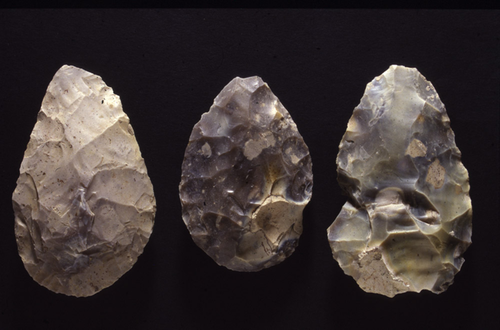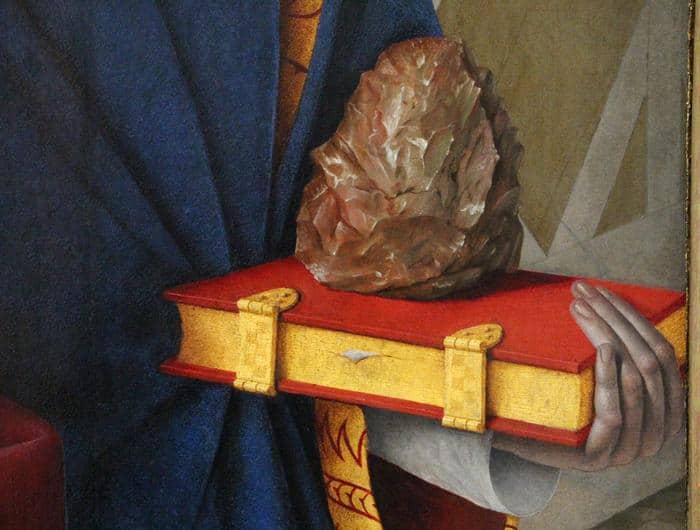A famous 15th-century painting was hiding a prehistoric secret in plain sight, researchers from Dartmouth University and the University of Cambridge have recently discovered. Their study revealed that what was previously assumed to be a symbol of St. Stephen’s martyrdom in Jean Fouquet’s Melun Diptych is, in fact, a prehistoric stone hand axe.

The painting we are talking about here is the Melun Diptych, an artwork created by renowned French court painter Jean Fouquet in the year 1455. A diptych is an artwork that has two hinged panels that can be folded like a book.
The left panel, which is the focus of this study, features St. Stephen holding a closed book, atop which rests a peculiar rock. Beside him, King Charles VII’s treasurer, Etienne Chevalier, is depicted in prayer. The right panel is a painting of the Virgin Mary and Christ the Child.
St. Stephen was stoned to death around 36 CE so the rock in Melun Diptych was always thought to be a symbol of his martyrdom. However, the new study suggests that the rock is an Acheulean hand axe, a stone tool that was used as early as 1.7 million years ago and is often considered one of the oldest tools made by humans. It’s unclear if the painter even knew what he was depicting.
What’s so special about an Acheulean handaxe?

These bifacial stone tools were prevalent about 300,000 years ago during the mid-paleolithic age. Being some of the oldest and most frequently used tools from prehistoric times, they hold significant archaeological interest.
“Acheulean handaxes are one of the most heavily investigated Palaeolithic artifacts. They also represent one of the few stone artifact types to have made their way into popular culture,” the study authors note.

Archaeological debates abound concerning the handaxes’ intended use. While many experts deem them cutting tools, others speculate they might have been thrown as weapons. Some propose their use as symbols of social status. For example, people have used them to show off their skills like “whose handaxe is the best or who is the best stone tool maker.”
Most scholars believe that their unique shape was deliberate, yet a few contend that repeated sharpening of a crude tool might naturally result in the hand axe form.
According to the researchers, before the 17th century, these axes weren’t recognized as man-made tools. They were termed “thunderstones,” believed to fall from the heavens during thunderstorms. But did this diptych show an Acheulean handaxe or are scientists misinterpreting something more mundane?
To investigate, the researchers closely examined the shape, color, and possible flake scars on the stone depicted in the Melun Diptych.
The analysis revealed that the stone strongly resembled real Acheulean hand axes. Additionally, the location where the painting originated, close to chalk bedrock, hinted at easy access to the flint used to make such Stone Age tools.
Did Jean Fouquet know about Stone Age handaxes?

Fouquet’s attention to detail in rendering the artifact and its similarity to real Stone Age hand axes in the region offer solid support to the researchers’ theory. Collectively, their analysis proposes a compelling case that the object in the painting is indeed a genuine prehistoric hand axe. However, this is no proof per se.
“We cannot state with absolute certainty that an Acheulean handaxe was painted by Jean Fouquet c. 1455. What we have done is demonstrate, as far as it is possible, that the stone object in the image is likely to be one,” the study authors said.
They also acknowledge that they have no idea if Fouquet was aware that he was painting a Stone Age handaxe.
“It is difficult to provide any firm resolution on why a handaxe was used by Fouquet within the painting. It could have been due to this object’s ubiquity within society, in which case it would have been depicted due to a shared understanding of such objects,” they added.
It is also possible that the handaxe was seen as a sacred object in religious, royal, or scholarly circles. This uniqueness might have been why it was included in the painting, as it wasn’t something most people were familiar with.
With this discovery, the world of art and archaeology intertwines, and future research may further illuminate the mysteries surrounding the Acheulean rock in the Melun Diptych.
But the Melun Diptych may have been hiding more than just a prehistoric tool.
A folding surprise
Another recent discovery suggests that Fouquet embedded a visual puzzle into the panels themselves—one that could only be seen if the hinged diptych were closed, as it would have been in its original setting.
Let’s rewind. The diptych was commissioned by Étienne Chevalier, Treasurer to the French kings Charles VII and Louis XI, and painted around 1455 for the Collegiate Church of Notre-Dame in Melun. The two panels—Chevalier and his patron saint St. Stephen on the left, the Madonna and Christ Child on the right—have been separated since the 18th century, now residing in Berlin and Antwerp. But in its original form, the work could be opened like a book or folded shut.
Monja Schünemann, a research assistant at Chemnitz University of Technology, was studying the composition when she decided to imagine the diptych closed.
“When I was intensively thinking about the composition of the entire diptych while looking at the left panel, a thought struck me like a bolt of lightning. On the same day, I made a mirror-image sketch of the panel on display in Berlin and superimposed it on the panel with the Madonna – I folded both panels together, so to speak,” the researcher explained.
What emerged was something startling: a hidden “sandwich image” that transforms the meaning of the artwork. In the closed configuration, Chevalier kneels within the folds of Mary’s open cloak, appearing to be mystically nourished by her breast. Disconcerting? Yes. But also very intriguing, especially as it is believed that this Madonna was based on Agnès Sorel, mistress of King Charles VII, who had died two years earlier.

“The two wings of the diptych thus become a lactatio, which in iconography denotes the miracle of nourishment from the Madonna’s breast. When the panels are folded together, it also becomes obvious that the Christ sitting on the Madonna’s lap can look into the chest of the breastfed and thus literally into the heart,” Schünemann describes her discovery.
This revelation also helps explain earlier technical studies that found Fouquet had altered the positions of both Chevalier’s head and St. Stephen’s during painting. Schünemann believes these corrections ensured that when the diptych was closed, the visual alignment would be perfect. The directions of the angels’ gazes on the right panel now also take on a previously unimagined meaning, she notes.
The possibility that Fouquet’s work conceals two secrets—one prehistoric, one theological (let’s leave it at that)—reshapes how art historians think about the Melun Diptych. Its apparent straightforwardness, whether as devotional portrait or as symbol-laden saintly tableau, now seems more like a deliberate game of visual concealment, meant to reveal itself only in private, to those who knew how to “read” it.
The study is published in the Cambridge Archaeological Journal.
The article was originally published on October 24, 2023, and was edited to include the “folding surprise” section.






